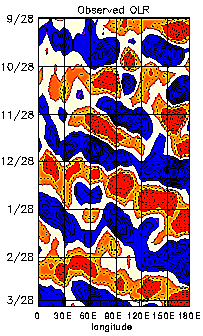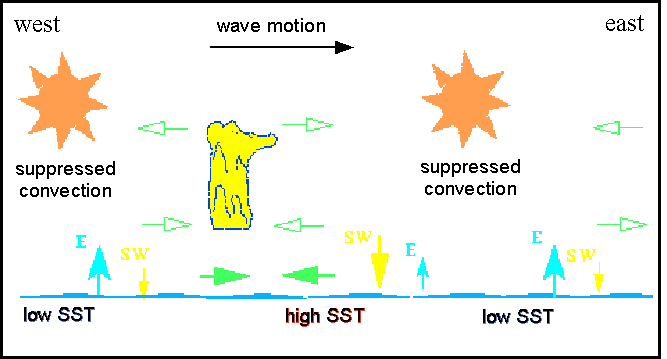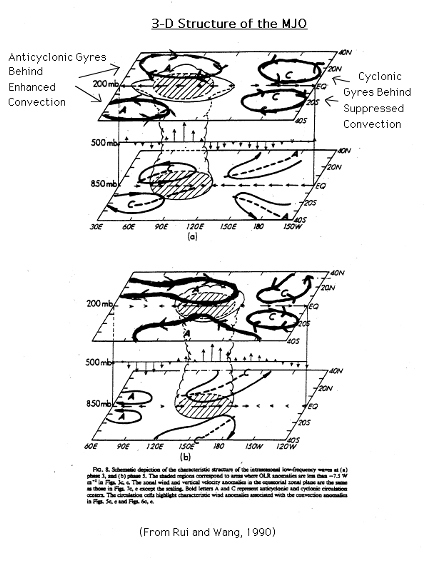The Madden-Julian oscillation
|
B. Geerts and M. Wheeler |
5/'98 |
Discovery
In the tropics weather is not as predictable as in mid-latitudes. That is because in mid-latitudes the weather variables (clouds, precipitation, wind, temperature, and pressure) are largely governed by the upper-tropospheric Rossby waves, which interact with surface weather in a process called baroclinic instability (Note 13.B). In the tropics there is no such dominant instability or wave motion, and therefore the weather is less predictable for the 1-10 day period. Until recently it was believed that tropical weather variations on time scales less than a year were essentially random.
In 1971 Roland Madden and Paul Julian (1) stumbled upon a 40-50 day oscillation when analysing zonal wind anomalies in the tropical Pacific. They used ten years of pressure records at Canton (at 2.8° S in the Pacific) and upper level winds at Singapore. The oscillation of surface and upper-level winds was remarkably clear in Singapore. Until the early 1980's little attention was paid to this oscillation, which became known as the Madden and Julian Oscillation (MJO), and some scientists questioned its global significance. Since the 1982-83 El Niño event, low-frequency variations in the tropics, both on intra-annual (less than a year) and inter-annual (more than a year) timescales, have received much more attention, and the number of MJO-related publications grew rapidly.
|
The MJO, also referred to as the 30-60 day or 40-50 day oscillation, turns out to be the main intra-annual fluctuation that explains weather variations in the tropics. The MJO affects the entire tropical troposphere but is most evident in the Indian and western Pacific Oceans. The MJO involves variations in wind, sea surface temperature (SST), cloudiness, and rainfall. Because most tropical rainfall is convective, and convective cloud tops are very cold (emitting little longwave radiation), the MJO is most obvious in the variation of outgoing longwave radiation (OLR), as measured by an infrared sensor on a satellite.
Figure 1 (from Elleman 1997) shows how the OLR anomalies in the eastern hemisphere propagate to the east at around 5 m/s. The OLR signal in the western hemisphere is weaker, and the recurrence interval for the eastward propagating OLR anomalies in the eastern hemisphere is about 30 to 60 days. How exactly the anomaly propagates from the dateline to Africa (i.e. through the western hemisphere) is not well understood. It appears that near the dateline a weak Kelvin wave propagates eastward and poleward at a speed exceeding 10 m/s.
Associated with the propagation of convective anomalies, the MJO involves variations in the global circulation. The MJO affects the intensity and break periods of the Asian and Australian monsoons and interacts with El Niño. Wet spells in the Australian monsoon occur about 40 days apart. Fairly weak correlations with the midlatitude rainfall patterns and jet stream characteristics have also been found (2). |

Fig 1: Departures from normal outgoing longwave radiation around the globe between 5° S and 5° N during 6 months (10/'91 through 3/'92). The contour interval is 5 Wm-2. Areas in blue have a negative anomaly exceeding 5 Wm-2, and areas in red have positive anomalies over 5 Wm-2. The data have been 'filtered' to remove high-frequency (<30 day) variations. |
Structure of a Madden-Julian wave
Within the center of suppressed convection, clear skies associated with a stronger-than-normal trade wind inversion allow more shortwave radiation to reach the ocean surface (Figure 2), causing a slight SST increase as the wave travels eastward (3). The Trade winds too are stronger than normal, explaining enhanced evaporation from the sea surface.

Fig 2: Schematic of the MJO. The cross section represents the equatorial belt around the globe, or just the eastern hemisphere. E stands for evaporation, SW for net shortwave radiation absorbed by the ocean. The converging bold green arrows indicate the location of strongest moisture convergence. The hollow green arrows show the anomalous circulation associated with the MJO. The areas of enhanced convection are indicated by the yellow schematic thunderstorm. (adapted from Elleman 1997)
Easterly winds (and the evaporation rate) weaken near the western edge of the suppressed convection region, and this leads to low-level moisture convergence. This triggers deep convection, leading to the other half of the OLR oscillation, i.e. the region of enhanced convection. This region is comprised of one or more super cloud clusters (SCCs) that move eastward along with the MJ wave. Within the SCCs, westward-moving cloud clusters form at the eastern edge of the SCC and die at the western edge. These smaller clusters have a lifetime of one to two days. In turn, the individual mesoscale convective systems within these smaller clusters typically move eastward, usually by discrete propagation, and have a lifetime of 6-12 hours. The SCCs travel eastward at 5-10 m/s, not as a long-lived storm complex, but rather as a moving wave or oscillation, i.e. the MJO. The MJO has a wavenumber of 1-2, that is at any time there are one or two areas around the equator with enhanced convection, and one or two with suppressed convection.
MJO Dynamics
|
Equatorially trapped waves (Kelvin and Rossby waves) that explain the evolution of an El Niño event (Note 11.C) are also the driving mechanism for the MJO. These waves occur in the entire troposphere from 30° N to 30° S, mainly in the eastern hemisphere. Surface air flows away from the suppressed convection in both zonal directions towards enhanced convection regions. In the upper troposphere, anomalous easterlies exit the west side of the enhanced convection (Figure 2). The strong westerlies from the east side of the enhanced convection flow into the region of suppressed convection (Figure 3, from (4)). When suppressed convection is strong from the Indian Ocean to the middle Pacific Ocean, anomalous cyclonic gyres at 200 mb trail the region of suppressed convection. Similarly, anticyclonic gyres at 200 mb trail the enhanced convection region once it becomes strong in the Indian and western Pacific Oceans. Gyres in the opposite sense are produced at surface, but they are much weaker than the ones at the tropopause. The zonal circulation and horizontal gyres are important processes by which the MJO shuffles mass around the tropics.
The explanation above is simplistic, in that it idealises the oscillation, as it isolates it from other variations. As mentioned before, the speed and size are variable, and the MJO mainly affects rainfall patterns in Indonesia and surrounding areas. Not all of the elements of the MJO -- convection, zonal wind, moisture convergence, and SST anomalies -- are always visible (5). It is only when the 30-60 day oscillations are extracted from a series of MJO events that the idealised picture of the MJO emerges. Consecutive oscillations have varying amplitudes, periods, and wavelengths. The MJO exhibits the mixed Kelvin-Rossby wave structure over the eastern hemisphere, but over the western hemisphere, it only shows a Kelvin wave structure. It moves through the eastern hemisphere at around 5 m/s and through the western hemisphere at a higher speed (at least 10 m/s). The oscillation is stronger in the northern hemisphere winter. It is also in this season that the negative OLR anomalies are most likely to propagate along the equator from the Indian Ocean to the central Pacific Ocean. In the northern hemisphere summer, many of the anomalies veer away from the tropics before they make it to the central Pacific (6). |

|
Notwithstanding its complexity and dependence on convection, the essence of the MJO (its periodicity, structure and zonal asymmetry) can be simulated in a GCM (7).
References
- Madden, R. A., and P. R. Julian, 1971: Detection of a 40-50 day oscillation in the zonal wind in the tropical Pacific.J. Atmos. Sci., 28, 702-708.
- Madden, R. A., and P. R. Julian, 1994: Observations of the 40-50 day tropical oscillation: a review. Mon. Wea. Rev., 122, 814-837.
- Jones, C., D.E. Waliser and C. Gautier 1998. The influence of the Madden-Julian Oscillation on ocean surface heat fluxes and sea-surface temperatures. J. Climate 11, 1057-72. (also on the web: Coupled modes of air-sea interaction and the Madden and Julian oscillation.)
- Rui, H., and B. Wang, 1990: Development characteristics and dynamic structure of tropical intraseasonal convection anomalies. J. Atmos. Sci., 47, 357-379.
- Jones, C. and B.C. Weare 1996. The role of low-level moisture convergence and ocean latent-heat fluxes in the Madden and Julian Oscillation. J. Climate, 9, 3086-104.
- Elleman, R. 1997: Predicting the Madden and Julian Oscillation Using a Statistical Model. (unpublished)
- Hayashi, Y. and D.G. Golder 1993. Tropical 40-50 and 25-30 day oscillations. J. Atmos. Sci., 50, 464-94.


